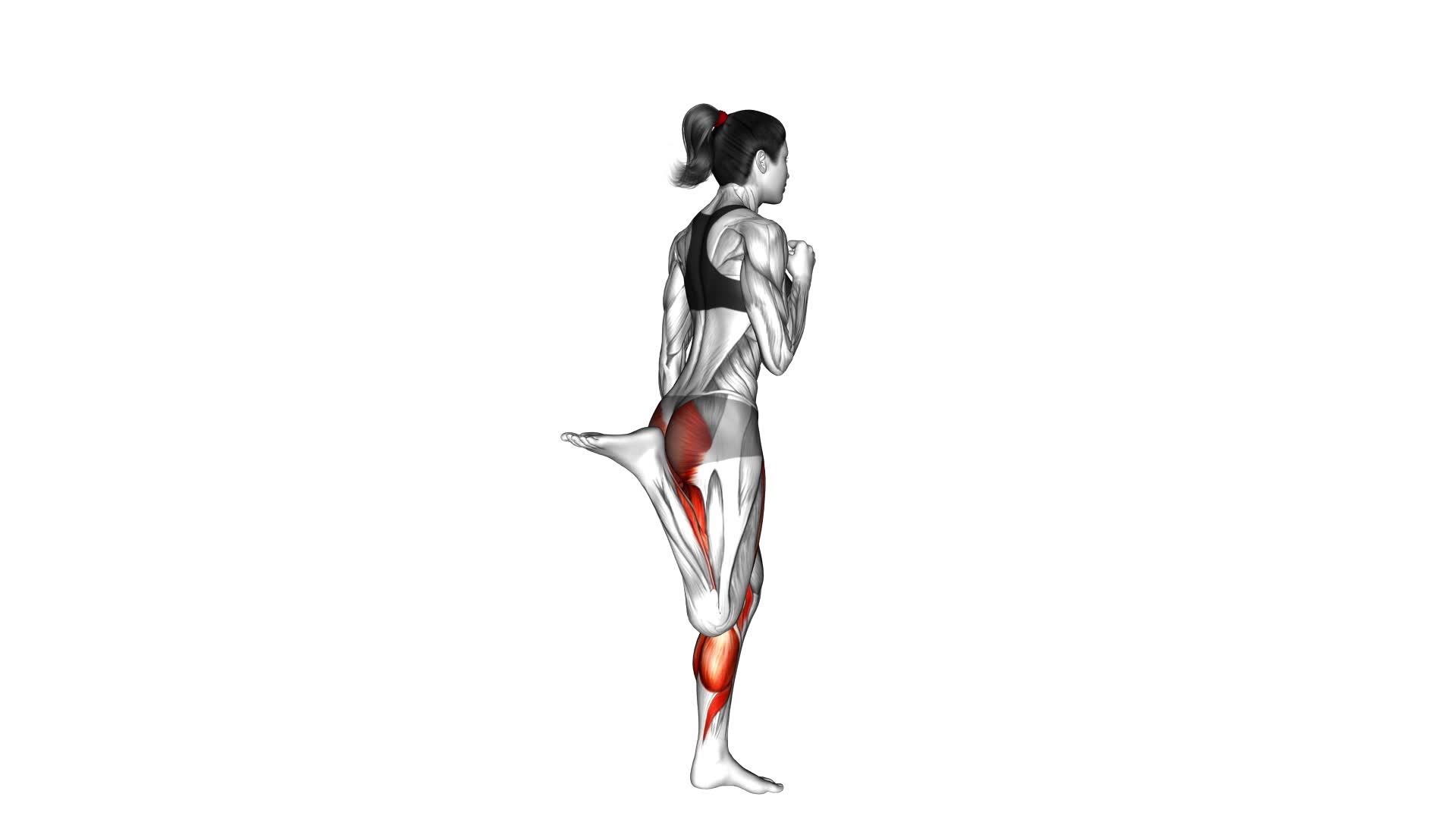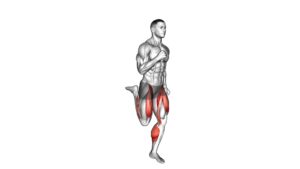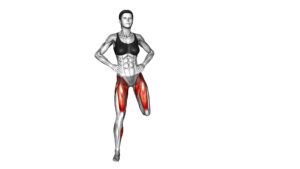Butt Kicks (female) – Video Exercise Guide & Tips

Are you looking to tone and strengthen your glutes? Look no further than this video exercise guide on butt kicks.
Watch This Exercise Video
In just a few minutes a day, you'll discover the benefits of this simple yet effective move for women.
From proper form and technique to modifications for different fitness levels, you'll learn it all.
Avoid common mistakes, maximize your results, and incorporate butt kicks into your workout routine.
Get ready to kick some butt!
Key Takeaways
- Butt kicks target multiple muscle groups
- Improve cardiovascular endurance
- Strengthen and tone leg muscles (quadriceps, hamstrings, glutes)
- Engage core muscles, improving stability and balance
Benefits of Butt Kicks for Women
You will experience several benefits from incorporating butt kicks into your workout routine as a woman. Butt kicks are a dynamic exercise that target multiple muscle groups, making them an effective addition to any fitness regimen. One of the main benefits of butt kicks is that they help improve cardiovascular endurance. By raising your heart rate and increasing blood flow throughout your body, butt kicks can enhance your overall stamina and endurance.
Additionally, butt kicks can help strengthen and tone your leg muscles, including your quadriceps, hamstrings, and glutes. These exercises also engage your core muscles, helping to improve stability and balance.
Proper breathing techniques are essential when performing butt kicks. It's important to breathe in a controlled manner, inhaling deeply through your nose and exhaling through your mouth. This helps supply oxygen to your working muscles and can enhance your overall performance.
Variations for different muscle groups can be incorporated into your butt kick routine. You can perform high kicks to target your hamstrings and glutes, or low kicks to engage your quadriceps. Another variation is to perform butt kicks while moving forward or backward, which can challenge your balance and coordination. Adding ankle weights or resistance bands can also intensify the exercise and further engage your muscles.
Now, let's move on to the next section and discuss proper form and technique for performing butt kicks.
Proper Form and Technique
To ensure proper form and technique when performing butt kicks, there are a few key points to keep in mind.
First, focus on maintaining good posture and alignment throughout the exercise, keeping your core engaged and shoulders relaxed.
Secondly, use muscle activation cues to maximize the effectiveness of the movement, such as actively pulling your heel towards your glutes with each kick.
Lastly, be aware of common mistakes to avoid, such as kicking too forcefully or rushing through the movement, to prevent injury and get the most out of your workout.
Posture and Alignment
Maintaining proper posture and alignment is essential for performing butt kicks effectively and safely. Improving your posture and alignment techniques can help you get the most out of this exercise while minimizing the risk of injury.
To start, stand tall with your feet hip-width apart and engage your core muscles by pulling your belly button towards your spine. Keep your shoulders relaxed and down, and avoid arching your back or rounding your shoulders.
As you kick your heels up towards your glutes, make sure to maintain a straight line from your head to your heels. This will help you engage the correct muscles and maximize the benefits of the exercise.
Now, let's move on to muscle activation cues to enhance your butt kicks even further.
Muscle Activation Cues
To enhance your butt kicks even further, focus on activating the correct muscles with proper form and technique. Muscle activation techniques are essential for improving muscle engagement during this exercise.
Start by maintaining an upright posture and engaging your core muscles. As you kick your heels towards your glutes, make sure to fully extend your legs and land softly on the balls of your feet. This will help activate your hamstrings, quadriceps, and glutes.
To maximize muscle engagement, keep a quick and controlled pace, aiming to bring your heels as close to your glutes as possible. By using the correct muscle activation cues, you can optimize the benefits of butt kicks and achieve better results.
Now, let's move on to the next section and learn about common mistakes to avoid.
Common Mistakes to Avoid
To ensure proper form and technique during butt kicks, it's important to be mindful of common mistakes that can hinder your progress and lead to injury.
One common mistake to avoid is kicking too high, which can strain your hamstrings and potentially cause injury. Instead, focus on bringing your heels up towards your glutes without overextending your legs.
Another mistake is leaning forward or arching your back excessively. This not only decreases the effectiveness of the exercise but also puts unnecessary strain on your lower back. Maintain an upright posture throughout the movement.
Lastly, avoid rushing through the exercise. Performing butt kicks too quickly can compromise your form and increase the risk of injury. Take your time and focus on executing each repetition with proper technique.
Modifications for Different Fitness Levels
Your fitness level will determine the modifications needed for performing butt kicks (female) effectively. If you're a beginner, it's important to start slowly and focus on proper form.
One modification for beginners is to perform butt kicks at a slower pace. This allows you to concentrate on engaging your glutes and hamstrings without sacrificing technique. Additionally, you can reduce the range of motion by bringing your heels only halfway up to your glutes. This modification can help beginners build strength and flexibility gradually.
On the other hand, if you're an advanced fitness enthusiast looking for a challenge, there are several variations you can try. One option is to increase the speed at which you perform butt kicks. This won't only elevate your heart rate, but also add an element of cardio to the exercise.
Another variation is to incorporate high knees with your butt kicks. This combination move engages both your lower and upper body, providing a full-body workout. Additionally, you can try adding ankle weights or resistance bands to increase the intensity of the exercise.
Common Mistakes to Avoid
Avoid these common mistakes when performing butt kicks (female) to ensure proper form and maximize the effectiveness of the exercise.
One common mistake is kicking your heels too high. While it may feel like you're getting a better workout by kicking your heels up to your glutes, it actually puts unnecessary strain on your knees and can lead to injury. Instead, focus on a controlled and controlled movement, kicking your heels up just below your glutes.
Another mistake to avoid is leaning forward or backward. This can throw off your balance and compromise the effectiveness of the exercise. Keep your torso upright and engage your core muscles to maintain stability.
Additionally, make sure you're using your arms correctly. Some people tend to swing their arms excessively, which can disrupt the natural rhythm of the exercise. Instead, keep your arms relaxed and swing them in a natural motion, opposite to the movement of your legs.
Lastly, don't rush through the exercise. Take your time and focus on each repetition, ensuring that you're fully extending your legs and feeling the contraction in your glutes.
Tips for Maximizing Results
For the best results, incorporate these tips into your butt kicks (female) exercise routine. Maximizing intensity and avoiding injury are key aspects to consider when aiming for optimal results.
To maximize the intensity of your butt kicks, focus on engaging your glutes and hamstrings with each kick. Make sure to kick your heels up towards your glutes as high as possible, while maintaining a brisk pace. This will help to activate and strengthen your muscles more effectively.
To avoid injury, it's important to warm up properly before starting your butt kicks routine. Perform dynamic stretches such as leg swings and hip circles to prepare your muscles for the workout. Additionally, maintain proper form throughout the exercise by keeping your core engaged, your back straight, and your shoulders relaxed. This will help to prevent strain on your lower back and joints.
To further enhance your results, consider incorporating variations of butt kicks into your routine. You can try performing them on an incline or by adding ankle weights for an added challenge. This will help to increase the intensity and target different muscle groups.
Incorporating Butt Kicks Into Your Workout Routine
To incorporate butt kicks into your workout routine, it's important to focus on proper form techniques. This includes engaging your core, keeping your back straight, and maintaining a steady pace.
The benefits of butt kicks include improving cardiovascular endurance, strengthening your lower body muscles, and increasing flexibility.
For an effective workout, try combining butt kicks with other exercises like high knees or jogging in place to target different muscle groups and maximize your results.
Proper Form Techniques
When incorporating butt kicks into your workout routine, focus on maintaining proper form and technique throughout the exercise. Proper form ensures that you maximize the benefits of stretching and minimize the risk of injury.
To perform butt kicks correctly, start by standing tall with your feet hip-width apart. Engage your core and keep your back straight. Begin by jogging in place, while simultaneously kicking your heels up towards your glutes. Keep your knees pointing down and your thighs parallel to the ground.
Aim for a fast and controlled movement, while maintaining a steady pace. Remember to breathe steadily throughout the exercise and avoid hunching over.
Benefits of Butt Kicks
To incorporate butt kicks into your workout routine and maximize their benefits, focus on maintaining proper form and technique throughout the exercise. Butt kicks offer a range of benefits for women, making them a valuable addition to any fitness regimen. Here are some key advantages of incorporating butt kicks into your workout routine:
- Cardiovascular Endurance:
- Butt kicks increase your heart rate and improve cardiovascular endurance, helping you build stamina and burn calories.
- They engage multiple muscle groups, including the glutes, hamstrings, and calves, making them an effective full-body exercise.
- Lower Body Strength:
- Butt kicks target the lower body muscles, helping to strengthen and tone the glutes, hamstrings, and quads.
- Regularly performing butt kicks can enhance your overall lower body strength, leading to improved performance in other exercises and daily activities.
Combining With Other Exercises
To incorporate butt kicks into your workout routine and maximize their benefits, you can combine them with other exercises for an even more effective and challenging workout.
One way to do this is by incorporating butt kicks into high-intensity interval training (HIIT) workouts. HIIT workouts involve alternating between short bursts of intense exercise and periods of rest or low-intensity exercise. By adding butt kicks to your HIIT routine, you can increase the intensity of your cardio workout and target your lower body muscles even more.
Another effective cardio combination is to pair butt kicks with other plyometric exercises, such as jump squats or burpees. This will help improve your explosive power and overall cardiovascular fitness.
Remember to always warm up before incorporating butt kicks into your workout routine and listen to your body to prevent injury.
Frequently Asked Questions
How Many Calories Do Butt Kicks Burn?
Butt kicks are a popular exercise for improving cardio and toning the legs. When it comes to burning calories, butt kicks can be quite effective. The exact number of calories burned will vary depending on factors such as your weight, intensity, and duration of the exercise.
However, on average, butt kicks can burn around 8-12 calories per minute. To maximize the calorie burn, focus on maintaining proper butt kicks technique and try incorporating variations of butt kicks into your workout routine.
Can Butt Kicks Help Reduce Cellulite on the Thighs?
Butt kicks are one of the best exercises for reducing cellulite on your thighs. They provide numerous benefits, including toning your glutes, hamstrings, and quadriceps. By engaging these muscles, butt kicks help to tighten and firm the skin, reducing the appearance of cellulite.
Incorporating butt kicks into your regular workout routine can be an effective way to target this common concern. So, start incorporating butt kicks into your fitness regimen and say goodbye to cellulite!
What Muscles Do Butt Kicks Target?
Butt kicks are a great exercise for targeting multiple muscles in your lower body. They primarily work your glutes, hamstrings, and calves.
By incorporating butt kicks into your workout routine, you can improve overall lower body strength and muscle tone.
To make your workout more challenging, you can try variations of butt kicks such as high knee butt kicks or jumping butt kicks.
These variations will engage your muscles even more and provide additional benefits for your fitness goals.
Can Butt Kicks Be Performed During Pregnancy?
Butt kicks can be modified to accommodate pregnancy. It's important to listen to your body and make adjustments as needed.
During pregnancy, butt kicks can help improve cardiovascular fitness, strengthen the glutes, hamstrings, and calf muscles, and increase overall lower body endurance.
However, it's always best to consult with your healthcare provider before starting any new exercise routine during pregnancy to ensure it's safe for you and your baby.
Are There Any Potential Risks or Injuries Associated With Butt Kicks?
When it comes to butt kicks, there are potential risks and common injuries that you should be aware of. These exercises can put strain on your hamstrings and calves if not done properly. It's important to warm up properly and gradually increase the intensity to prevent muscle strains or tears.
Additionally, if you have any pre-existing knee or ankle issues, butt kicks may exacerbate these conditions. Always listen to your body and stop if you experience any pain or discomfort.
Conclusion
Incorporating butt kicks into your workout routine can be a great way for women to improve their cardiovascular endurance, strengthen their leg muscles, and enhance their overall fitness.
By focusing on proper form and technique, avoiding common mistakes, and making modifications as needed, you can maximize the results of this exercise.
Whether you're a beginner or more advanced, adding butt kicks to your fitness regimen can help you achieve your goals and take your workouts to the next level.

Author
Years ago, the spark of my life’s passion ignited in my mind the moment I stepped into the local gym for the first time. The inaugural bead of perspiration, the initial endeavor, the very first surge of endorphins, and a sense of pride that washed over me post-workout marked the beginning of my deep-seated interest in strength sports, fitness, and sports nutrition. This very curiosity blossomed rapidly into a profound fascination, propelling me to earn a Master’s degree in Physical Education from the Academy of Physical Education in Krakow, followed by a Sports Manager diploma from the Jagiellonian University. My journey of growth led me to gain more specialized qualifications, such as being a certified personal trainer with a focus on sports dietetics, a lifeguard, and an instructor for wellness and corrective gymnastics. Theoretical knowledge paired seamlessly with practical experience, reinforcing my belief that the transformation of individuals under my guidance was also a reflection of my personal growth. This belief holds true even today. Each day, I strive to push the boundaries and explore new realms. These realms gently elevate me to greater heights. The unique combination of passion for my field and the continuous quest for growth fuels my drive to break new ground.







